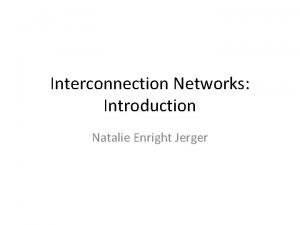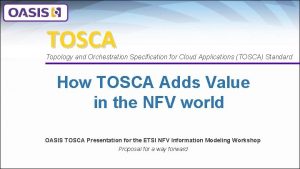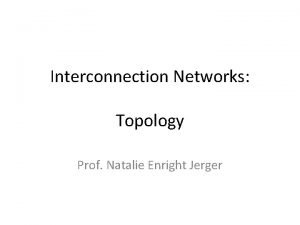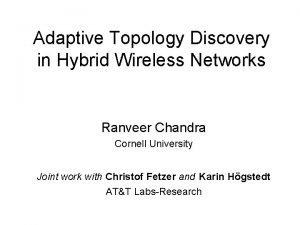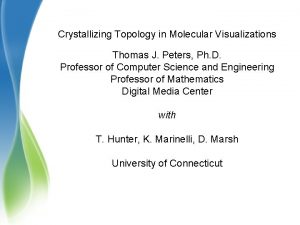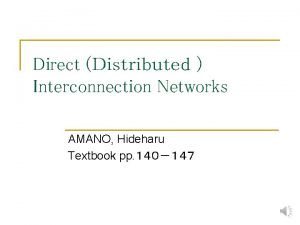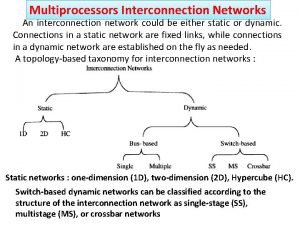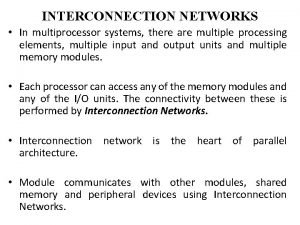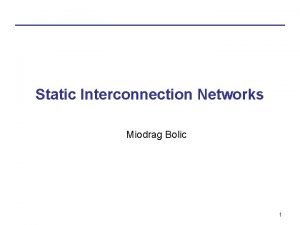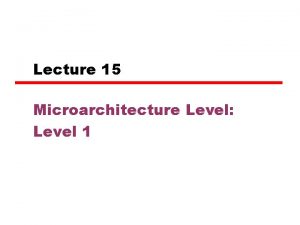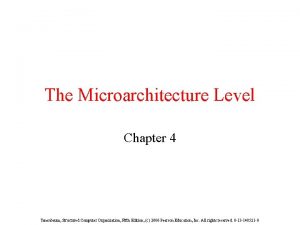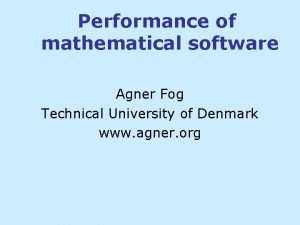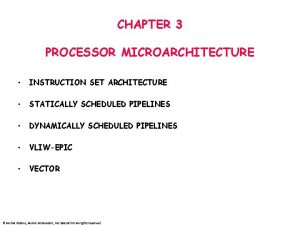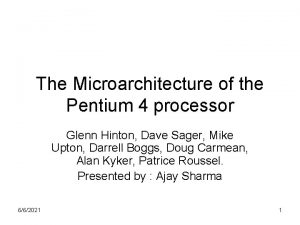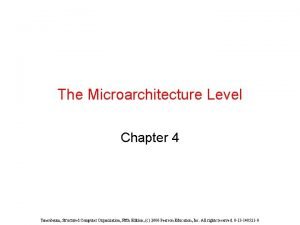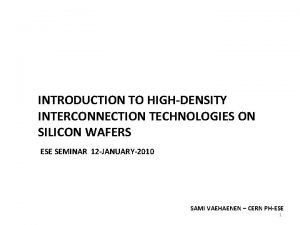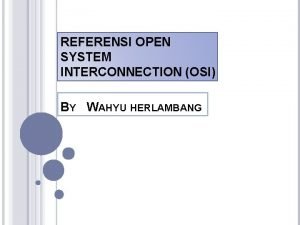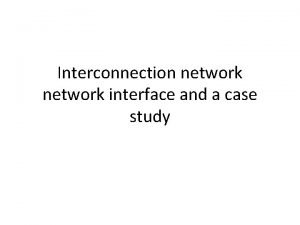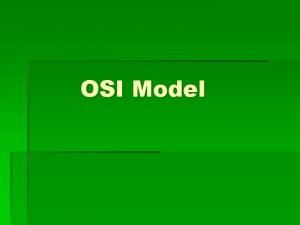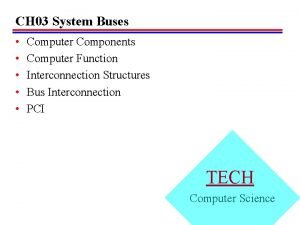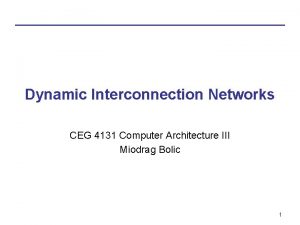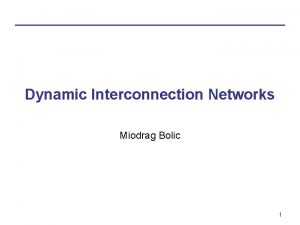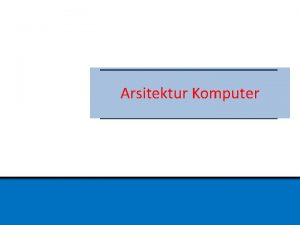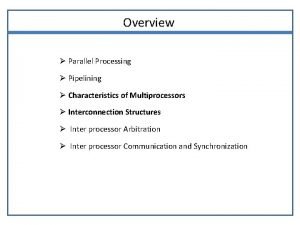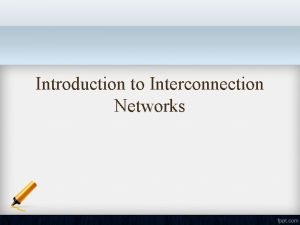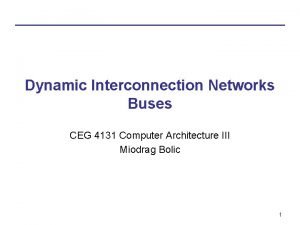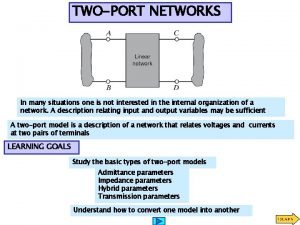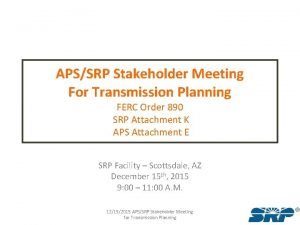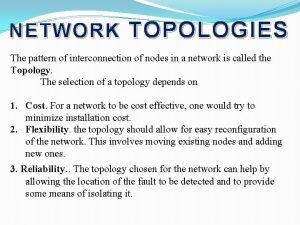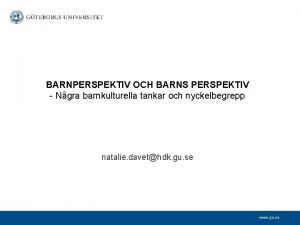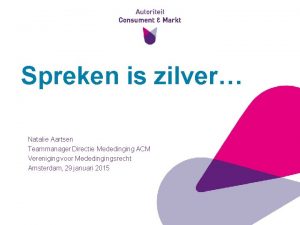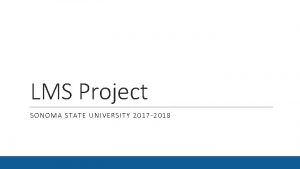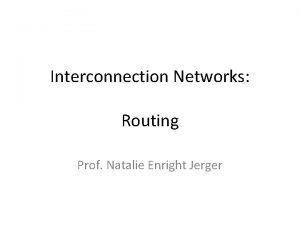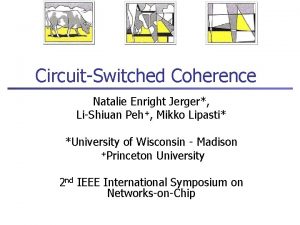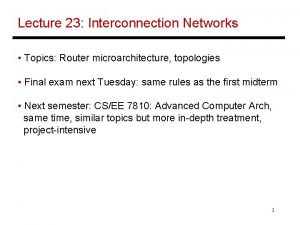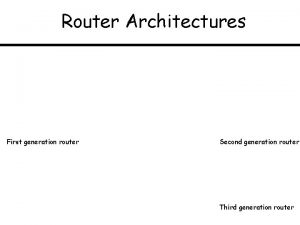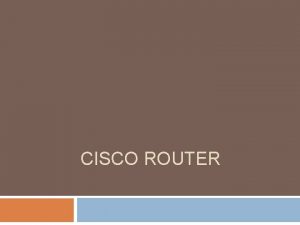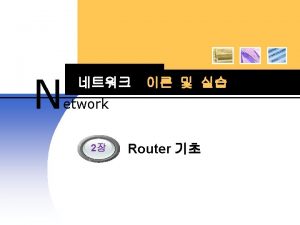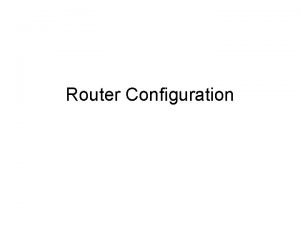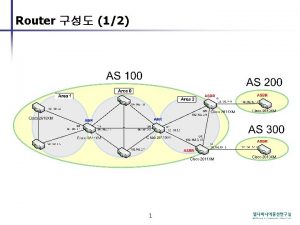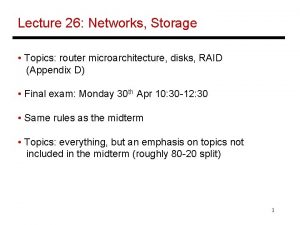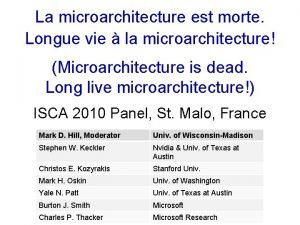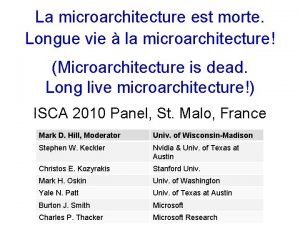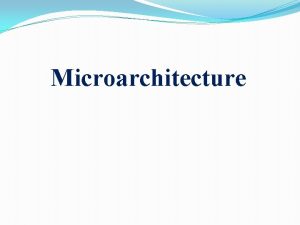Interconnection Networks Router Microarchitecture Prof Natalie Enright Jerger





























































- Slides: 61

Interconnection Networks: Router Microarchitecture Prof. Natalie Enright Jerger Fall 2014 ECE 1749 H: Interconnection Networks (Enright Jerger) 1

Introduction • Topology: connectivity • Routing: paths • Flow control: resource allocation • Router microarchitecture: implementation of routing, flow control and router pipeline – Impacts per-hop delay and energy Fall 2014 ECE 1749 H: Interconnection Networks (Enright Jerger) 2

Router Microarchitecture Overview • Focus on microarchitecture of Virtual Channel (VC) router – Router complexity increase with bandwidth demands – Simple routers built when high throughput is not needed • Wormhole flow control, unpipelined, limited buffers Fall 2014 ECE 1749 H: Interconnection Networks (Enright Jerger) 3

Virtual Channel Router Credits In Credits Out VC Allocator Route Computation Switch Allocator VC 1 Input 1 VC 2 Output 1 VC 3 VC 4 Input buffers VC 1 VC 2 Input 5 VC 3 Output 5 VC 4 Fall 2014 Input buffers. Interconnection Networks (Enright ECE 1749 H: Jerger)switch Crossbar 4

Router Components • Input buffers, route computation logic, virtual channel allocator, switch allocator, crossbar switch • Most OCN routers are input buffered – Use single-ported memories • Buffer store flits for duration in router – Contrast with processor pipeline that latches between stages Fall 2014 ECE 1749 H: Interconnection Networks (Enright Jerger) 5

Baseline Router Pipeline BW RC VA SA ST LT • Logical stages – Fit into physical stages depending on frequency • Canonical 5 -stage pipeline – – – BW: Buffer Write RC: Routing computation VA: Virtual Channel Allocation SA: Switch Allocation ST: Switch Traversal – LT: Link Traversal Fall 2014 ECE 1749 H: Interconnection Networks (Enright Jerger) 6

Baseline Router Pipeline (2) Head Body 1 Body 2 Tail 1 2 3 4 5 6 BW RC VA SA ST LT SA ST BW BW BW 7 8 9 LT • Routing computation performed once per packet • Virtual channel allocated once per packet • Body and tail flits inherit this info from head flit Fall 2014 ECE 1749 H: Interconnection Networks (Enright Jerger) 7

Router Pipeline Performance • Baseline (no load) delay • Ideally, only pay link delay • Techniques to reduce pipeline stages Fall 2014 ECE 1749 H: Interconnection Networks (Enright Jerger) 8

Pipeline Optimizations: Lookahead Routing • At current router perform routing computation for next router – Overlap with BW BW RC VA SA ST LT – Precomputing route allows flits to compete for VCs immediately after BW – RC decodes route header – Routing computation needed at next hop • Can be computed in parallel with VA Fall 2014 ECE 1749 H: Interconnection Networks (Enright Jerger) 9

Atomic Modules and Dependencies in Router Decode + Routing Switch Arbitration Crossbar Traversal Wormhole Router Decode + Routing VC Allocation Switch Arbitration Crossbar Traversal Virtual Channel Router VC Allocation Decode + Routing Speculative Switch Arbitration Speculative Virtual Channel Router Crossbar Traversal • Dependence between output of one module and input of another – Determine critical path through router – Cannot bid for switch port until routing performed Fall 2014 ECE 1749 H: Interconnection Networks (Enright Jerger) 10

Atomic Modules • Some components of router cannot be easily pipelined • Example: pipeline VC allocation – Grants might not be correctly reflected before next allocation • Separable allocator: many wires connecting input/output stages – Require latches if pipelined Fall 2014 ECE 1749 H: Interconnection Networks (Enright Jerger) 11

Pipeline Optimizations: Speculation • Assume that Virtual Channel Allocation stage will be successful – Valid under low to moderate loads • Entire VA and SA in parallel BW RC VA SA ST LT • If VA unsuccessful (no virtual channel returned) – Must repeat VA/SA in next cycle • Prioritize non-speculative requests Fall 2014 ECE 1749 H: Interconnection Networks (Enright Jerger) 12

Pipeline Optimizations: Bypassing • When no flits in input buffer – Speculatively enter ST – On port conflict, speculation aborted VA RC Setup ST LT – In the first stage, a free VC is allocated, next routing is performed and the crossbar is setup Fall 2014 ECE 1749 H: Interconnection Networks (Enright Jerger) 13

Pipeline Bypassing 1 a Lookahead Routing Computation Virtual Channel Allocation Inject N 1 A 1 b S E W Eject • No buffered flits when A arrives Fall 2014 N S E 2 ECE 1749 H: Interconnection Networks (Enright Jerger) W 14

Speculation 1 a Lookahead Routing Computation 1 B 1 A 1 c 1 c Virtual Channel Allocation 2 a Switch Allocation 2 b Inject 3 Port conflict detected 1 b N A succeeds in VA but fails in SA, retry SA 1 b S E W Eject N S E W 4 Fall 2014 ECE 1749 H: Interconnection Networks (Enright Jerger) 3 15

Buffer Organization Physical channels Virtual channels • Single buffer per input • Multiple fixed length queues per physical channel Fall 2014 ECE 1749 H: Interconnection Networks (Enright Jerger) 16

Buffer Organization VC 0 VC 1 tail head • Multiple variable length queues – Multiple VCs share a large buffer – Each VC must have minimum 1 flit buffer • Prevent deadlock – More complex circuitry Fall 2014 ECE 1749 H: Interconnection Networks (Enright Jerger) 17

Buffer Organization • Many shallow VCs? • Few deep VCs? • More VCs ease HOL blocking – More complex VC allocator • Light traffic – Many shallow VCs – underutilized • Heavy traffic – Few deep VCs – less efficient, packets blocked due to lack of VCs Fall 2014 ECE 1749 H: Interconnection Networks (Enright Jerger) 18

Switch Organization • Heart of datapath – Switches bits from input to output • High frequency crossbar designs challenging • Crossbar composed for many multiplexers – Common in low-frequency router designs • Long wires: repeater insertion i 40 i 30 i 20 i 10 i 00 sel 0 o 0 Fall 2014 sel 1 o 1 sel 2 o 2 sel 3 o 3 ECE 1749 H: Interconnection Networks (Enright Jerger) sel 4 o 4 19

Switch Organization: Crosspoint Inject w columns N w rows S E W Eject N S E W • Area and power scale at O((pw)2) – p: number of ports (function of topology) – w: port width in bits (determines phit/flit size and impacts packet energy and delay) Fall 2014 ECE 1749 H: Interconnection Networks (Enright Jerger) 20

Crossbar speedup 10: 5 crossbar 5: 10 crossbar 10: 10 crossbar • Increase internal switch bandwidth • Simplifies allocation or gives better performance with a simple allocator – More inputs to select from higher probability each output port will be matched (used) each cycle Fall 2014 ECE 1749 H: Interconnection Networks (Enright Jerger) 21

Physical channel MUX Cross. Bar MUX . . . Input buffers DEMUX Physical channel Link Control Switch Microarchitecture: No Speedup Routing Control and Arbitration Unit Fall 2014 ECE 1749 H: Interconnection Networks (Enright Jerger) 22

Physical channel MUX Cross. Bar MUX . . . Physical channel Link Control Fall 2014 Input buffers DEMUX Switch input speedup Input buffers DEMUX Physical channel Link Control Switch Microarchitecture: Speedup Routing Control and Arbitration Unit ECE 1749 H: Interconnection Networks (Enright Jerger) 23

Fall 2014 ECE 1749 H: Interconnection Networks (Enright Jerger) Physical channel . . . MUX MUX Routing Control and Arbitration Unit . . . MUX Cross. Bar Output buffers DEMUX . . . Output buffers DEMUX Input buffers DEMUX Physical channel Link Control Switch Microarchitecture: Speedup Switch input & output speedup 24

Crossbar Dimension Slicing • Crossbar area and power grow with O((pw)2) Inject E-in E-out W-in W-out N-in N-out S-in S-out Eject • Replace 1 5 x 5 crossbar with 2 3 x 3 crossbars • Suited to DOR – Traffic mostly stays within 1 dimension Fall 2014 ECE 1749 H: Interconnection Networks (Enright Jerger) 25

Arbiters and Allocators • Allocator matches N requests to M resources • Arbiter matches N requests to 1 resource • Resources are VCs (for virtual channel routers) and crossbar switch ports. Fall 2014 ECE 1749 H: Interconnection Networks (Enright Jerger) 26

Arbiters and Allocators (2) • Virtual-channel allocator (VA) – Resolves contention for output virtual channels – Grants them to input virtual channels • Switch allocator (SA) that grants crossbar switch ports to input virtual channels • Allocator/arbiter that delivers high matching probability translates to higher network throughput. – Must also be fast and/or able to be pipelined • VC allocation typically determines cycle time Fall 2014 ECE 1749 H: Interconnection Networks (Enright Jerger) 27

Fairness • Intuitively, a fair arbiter is one that provides equal service to different requesters • Weak fairness: Every request is eventually served • Strong fairness: Requesters will be served equally often • FIFO Fairness: Requesters are served in the order they make their requests Fall 2014 ECE 1749 H: Interconnection Networks (Enright Jerger) 28

Locally Fair Example 0. 125 r 0 0. 25 A 0 0. 125 r 1 A 1 0. 25 0. 5 A 2 1. 0 Destination 0. 5 r 2 r 3 • R 3 receives 4 times the bandwidth as r 0, even though individual arbiters provide strong fairness Fall 2014 ECE 1749 H: Interconnection Networks (Enright Jerger) 29

Round Robin Arbiter • Last request serviced given lowest priority • Generate the next priority vector from current grant vector • If no requests, priority is unchanged • Exhibits fairness Fall 2014 ECE 1749 H: Interconnection Networks (Enright Jerger) 30

Round Robin (2) Grant 0 Grant 1 Next priority 0 Priority 0 Next priority 1 Priority 1 Next priority 2 Priority 2 Grant 2 • Gi granted, next cycle Pi+1 high Fall 2014 ECE 1749 H: Interconnection Networks (Enright Jerger) 31

Weighted Round-Robin Arbiter preset Weight p r d Count = 0 Arbiter g • Disable request if input has already reached its quota Fall 2014 ECE 1749 H: Interconnection Networks (Enright Jerger) 32

Matrix Arbiter • Least recently served priority scheme • Triangular array of state bits wij for j < i – Bit wij indicates request i takes priority over j – Each time request k granted, clears all bits in row k and sets all bits in column k • Good for small number of inputs • Fast, inexpensive and provides strong fairness Fall 2014 ECE 1749 H: Interconnection Networks (Enright Jerger) 33

Request 0 Matrix Arbiter (2) Grant 0 01 02 Request 1 Grant 1 10 12 Request 2 Grant 2 20 Disable 0 Fall 2014 21 Disable 2 ECE 1749 H: Interconnection Networks (Enright Jerger) 34

Matrix Arbiter (3) Request 0 Grant 0 01 02 0 Request 1 Grant 1 012 10 Request 2 Grant 2 20 1 21 Disable 0 Disable 1 Disable 2 • When a request is asserted – AND-ed with the state bits in its row to disable any lower priority requests – Outputs of AND gates in column are OR-ed together to generate disable signal Fall 2014 ECE 1749 H: Interconnection Networks (Enright Jerger) 35

Matrix Arbiter (4) 0 1 1 0 gg 2 j gi g 2 g 0 10 0 1 w 2, 0 wij w 0, 2 • If Request 2 granted – Clear row 2 – Set column 2 Fall 2014 ECE 1749 H: Interconnection Networks (Enright Jerger) 36

Request 0 Matrix Arbiter Example Grant 0 0 01 0 02 Request 1 Grant 1 1 10 Request 2 Grant 2 20 1 Disable 0 Fall 2014 A 2 A 1 01 0 01 1 Disable 1 B 1 C 2 C 1 Disable 2 Bit [1, 0] = 1, Bit [2, 0] = 1 1 and 2 have priority over 0 Bit [2, 1] = 1 2 has priority over 1 C 1 (Req 2) granted ECE 1749 H: Interconnection Networks (Enright Jerger) 37 0 1 2

Request 0 Matrix Arbiter Example (2) Grant 0 0 01 1 02 Request 1 Grant 1 1 10 Request 2 Grant 2 20 0 Disable 0 Fall 2014 A 2 A 1 01 1 C 2 01 0 Disable 1 B 1 Disable 2 Set column 2, clear row 2 Bit [1, 0] = 1, Bit [1, 2] = 1 Req 1 has priority over 0 and 2 Grant B 1 (Req 1) ECE 1749 H: Interconnection Networks (Enright Jerger) 38

Request 0 Matrix Arbiter Example (3) Grant 0 1 01 1 02 Request 1 Grant 1 0 10 Request 2 Grant 2 20 0 Disable 0 Fall 2014 A 2 A 1 01 0 C 2 01 1 Disable 2 Set column 1, clear row 1 Bit [0, 1] = 1, Bit [0, 2] = 1 Req 0 has priority over 1 and 2 Grant A 1 (Req 0) ECE 1749 H: Interconnection Networks (Enright Jerger) 39

Request 0 Matrix Arbiter Example (4) Grant 0 0 01 0 02 Request 1 Grant 1 1 10 Request 2 Grant 2 20 1 Disable 0 Fall 2014 A 2 01 0 C 2 01 1 Disable 2 Set column 0, clear row 0 Bit [2, 0] = 1, Bit [2, 1] = 1 Req 2 has priority over 0 and 1 Grant C 2 (Req 2) 40

Request 0 Matrix Arbiter Example (5) Grant 0 0 01 1 02 Request 1 Grant 1 1 10 A 2 01 1 Request 2 Grant 2 20 0 Disable 0 01 0 Disable 1 Disable 2 Set column 2, clear row 2 Grant Request A 2 Fall 2014 ECE 1749 H: Interconnection Networks (Enright Jerger) 41

Allocators • Arbiter assigns a single resource to one of a group of requesters • Allocator performs a matching between a group of resources and a group of requestors – Each of which may request one or more resources • 3 rules – A grant can be asserted only if the corresponding request is asserted – At most one grant for each input (requester) may be asserted – At most one grant for each output (resource) can be asserted Fall 2014 ECE 1749 H: Interconnection Networks (Enright Jerger) 42

Allocation Example • Request Matrix, R = G 1 = 1 1 1 0 1 0 0 0 0 1 0 0 0 0 0 G 2 = • Both G 1 an G 2 satisfy rules but G 2 is more desirable – All three resources assigned to inputs – Maximum matching: solution containing maximum possible number of assignments Fall 2014 ECE 1749 H: Interconnection Networks (Enright Jerger) 43

Exact Algorithms • Allocation problem can be represented as a bipartite graph • Exact algorithms not feasible in time budget of router • Useful to compare a new heuristic against Fall 2014 ECE 1749 H: Interconnection Networks (Enright Jerger) 44

Augmenting Paths Algorithm • Start with sub-optimal matching of the bipartite graph • Construct a directed residual graph – If an edge is in the current matching, M, it points from its output to input • Now augmenting path is found – Any directed path through the residual graph from an unmatched input to an unmatched output – Matching is updated using this path Fall 2014 ECE 1749 H: Interconnection Networks (Enright Jerger) 45

Augmenting Paths Example 0 0 R= 1 Fall 2014 1 2 2 3 3 4 4 5 5 1 1 0 0 0 1 0 0 0 1 1 1 0 0 0 0 1 1 0 ECE 1749 H: Interconnection Networks (Enright Jerger) 46

Augmenting Paths Example 0 0 R= 1 Fall 2014 1 2 2 3 3 4 4 5 5 1 1 0 0 0 1 0 0 0 1 1 1 0 0 0 0 1 1 0 ECE 1749 H: Interconnection Networks (Enright Jerger) 47

Augmenting Paths Example 0 0 R= 1 Fall 2014 1 2 2 3 3 4 4 5 5 1 1 0 0 0 1 0 0 0 1 1 1 0 0 0 0 1 1 0 ECE 1749 H: Interconnection Networks (Enright Jerger) 48

Augmenting Paths Example 0 0 R= 1 Fall 2014 1 2 2 3 3 4 4 5 5 1 1 0 0 0 1 0 0 0 1 1 1 0 0 0 0 1 1 0 ECE 1749 H: Interconnection Networks (Enright Jerger) 49

Augmenting Paths Example 0 0 R= 1 Fall 2014 1 2 2 3 3 4 4 5 5 1 1 0 0 0 1 0 0 0 1 1 1 0 0 0 0 1 1 0 ECE 1749 H: Interconnection Networks (Enright Jerger) 50

Augmenting Paths Example 0 0 R= 1 Fall 2014 1 2 2 3 3 4 4 5 5 1 1 0 0 0 1 0 0 0 1 1 1 0 0 0 0 1 1 0 ECE 1749 H: Interconnection Networks (Enright Jerger) 51

Augmenting Paths Example 0 0 R= 1 Fall 2014 1 2 2 3 3 4 4 5 5 1 1 0 0 0 1 0 0 0 1 1 1 0 0 0 0 1 1 0 ECE 1749 H: Interconnection Networks (Enright Jerger) 52

Wavefront Allocator • Arbitrates among requests for inputs and outputs simultaneously • Row and column tokens granted to diagonal group of cells • If a cell is requesting a resource, it will consume row and column tokens – Request is granted • Cells that cannot use tokens – Pass row tokens to right and column tokens down Fall 2014 ECE 1749 H: Interconnection Networks (Enright Jerger) 53

Wavefront Allocator Example Tokens inserted at P 0 A requestingp 0 Resources 0, 1 , 2 B requesting p 1 Resources 0, 1 C requesting Resource 0 p 2 D requesting Resources 0, p 3 2 Fall 2014 00 01 02 03 Entry [0, 0] receives grant, consumes token Remaining tokens pass down and right 10 11 12 13 20 21 22 23 30 31 32 33 [3, 2] receives 2 tokens and is granted 54

Wavefront Allocator Example p 0 00 p 1 10 01 11 02 12 03 13 [1, 1] receives 2 tokens and granted All wavefronts propagated p 2 p 3 Fall 2014 20 21 22 23 30 31 32 33 55

Separable Allocator • Need for pipelineable allocators • Allocator composed of arbiters – Arbiter chooses one out of N requests to a single resource • Separable switch allocator – First stage: select single request at each input port – Second stage: selects single request for each output port Fall 2014 ECE 1749 H: Interconnection Networks (Enright Jerger) 56

Separable Allocator Requestor 1 requesting resource A Requestor 1 requesting resource C 3: 1 arbiter Requestor 4 requesting resource A 3: 1 arbiter 4: 1 arbiter Resource A granted to Requestor 1 Resource A granted to Requestor 2 Resource A granted to Requestor 3 Resource A granted to Requestor 4 4: 1 arbiter Resource C granted to Requestor 1 Resource C granted to Requestor 2 Resource C granted to Requestor 3 Resource C granted to Requestor 4 • A 3: 4 allocator • First stage: 3: 1 – ensures only one grant for each input • Second stage: 4: 1 – only one grant asserted for each output Fall 2014 ECE 1749 H: Interconnection Networks (Enright Jerger) 57

Separable Allocator Example A B C 3: 1 arbiter A B 3: 1 arbiter A C 3: 1 arbiter Requestor 1 wins A 4: 1 arbiter Requestor 4 wins C • Input-first allocator • 4 requestors, 3 resources • Arbitrate locally among requests – Local winners passed to second stage Fall 2014 ECE 1749 H: Interconnection Networks (Enright Jerger) 58

Adaptive Routing & Allocator Design • Deterministic routing – Single output port – Switch allocator bids for output port • Adaptive routing – Returns multiple candidate output ports • Switch allocator can bid for all ports • Granted port must match VC granted – Return single output port • Reroute if packet fails VC allocation Fall 2014 ECE 1749 H: Interconnection Networks (Enright Jerger) 59

Speculative VC Router • Non-speculative switch requests must have higher priority than speculative ones – Two parallel switch allocators • 1 for speculative • 1 for non-speculative • From output, choose non-speculative over speculative – Possible for flit to succeed in speculative switch allocation but fail in virtual channel allocation • Done in parallel • Speculation incorrect – Switch reservation is wasted – Body and Tail flits: non-speculative switch requests • Do not perform VC allocation inherit VC from head flit Fall 2014 ECE 1749 H: Interconnection Networks (Enright Jerger) 60

Microarchitecture Summary • Ties together topological, routing and flow control design decisions • Pipelined for fast cycle times • Area and power constraints important in No. C design space Fall 2014 ECE 1749 H: Interconnection Networks (Enright Jerger) 61
 Natalie enright jerger
Natalie enright jerger Natalie enright jerger
Natalie enright jerger Natalie dana enright jerger
Natalie dana enright jerger Natalie enright jerger
Natalie enright jerger Helen enright
Helen enright Natalie enright jerger
Natalie enright jerger Natalie enright jerger
Natalie enright jerger Direct interconnection networks
Direct interconnection networks Dynamic interconnection network in computer architecture
Dynamic interconnection network in computer architecture Interconnection networks in multiprocessor systems
Interconnection networks in multiprocessor systems Miodrag bolic
Miodrag bolic Microarchitecture level
Microarchitecture level Computer microarchitecture
Computer microarchitecture Microarchitecture vs isa
Microarchitecture vs isa Agner fog vcl
Agner fog vcl Processor microarchitecture
Processor microarchitecture Pentium 4 microarchitecture
Pentium 4 microarchitecture Microarchitecture diagram
Microarchitecture diagram Enright forgiveness model
Enright forgiveness model Christina enright
Christina enright Aisling enright
Aisling enright Test de marcha valores normales
Test de marcha valores normales Backbone networks in computer networks
Backbone networks in computer networks Difference between datagram and virtual circuit operation
Difference between datagram and virtual circuit operation Introduction to high density interconnects
Introduction to high density interconnects Model open system interconnection
Model open system interconnection Network interconnection studies
Network interconnection studies Define osi reference model
Define osi reference model Computer function and interconnection
Computer function and interconnection Interrupt in computer architecture
Interrupt in computer architecture Business registers interconnection system (bris)
Business registers interconnection system (bris) Business registers interconnection system
Business registers interconnection system Chordal ring
Chordal ring Model open system interconnection
Model open system interconnection Bus interconnection scheme diagram
Bus interconnection scheme diagram Dynamic interconnection network in computer architecture
Dynamic interconnection network in computer architecture Bratislav milanovic
Bratislav milanovic Interconnection architecture
Interconnection architecture Characteristics of multiprocessor system
Characteristics of multiprocessor system Characteristics of vector processing
Characteristics of vector processing Lara srivastava
Lara srivastava Computer buses
Computer buses Two ports containing no sources then
Two ports containing no sources then Aps interconnection queue
Aps interconnection queue Bris business registers interconnection system
Bris business registers interconnection system Computer components top level view
Computer components top level view Star topology disadvantages
Star topology disadvantages Natalie davet
Natalie davet Youtube
Youtube Section 2 acceleration answer key
Section 2 acceleration answer key Natalie aartsen
Natalie aartsen Lauren hoover little rock
Lauren hoover little rock Natalie skead
Natalie skead Natalie svoboda
Natalie svoboda Lauren hoover
Lauren hoover 4 seasons cycle
4 seasons cycle Natalie grimes
Natalie grimes Palivizumb
Palivizumb Calvin amin
Calvin amin Ssu moodle
Ssu moodle Nicole rafidi
Nicole rafidi Natalie cramp
Natalie cramp
